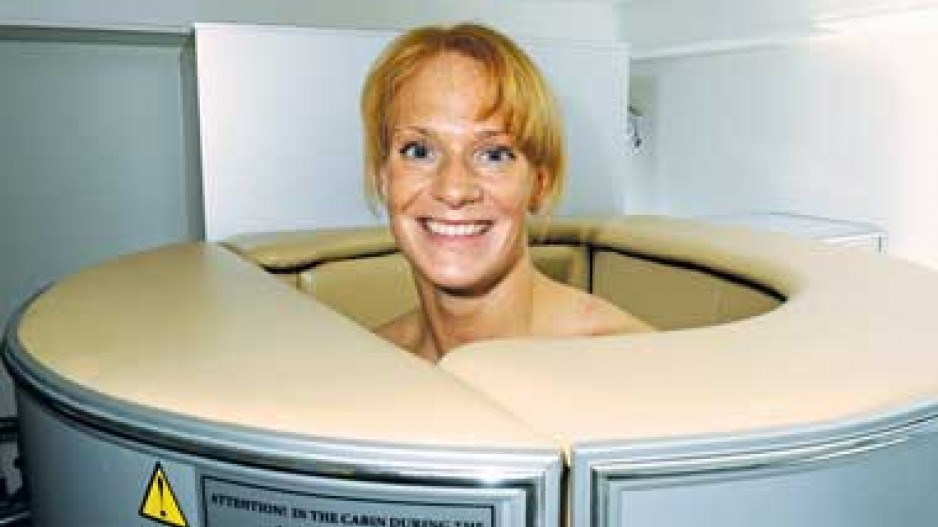At first blush, it sounds like the kind of business proposal that would be laughed off the set of Dragon's Den: charge people $45 to $70 a pop to stand half-naked for three minutes in a chamber that blasts them with liquid nitrogen vapour at -110 degrees Celsius or lower.
Then again, whole body cryotherapy claims to offer numerous physical and even mental benefits, including pain relief, muscle trauma recovery, anti-aging, weight loss and relief from anxiety and depression.
"You burn 800 calories in three minutes," said Jared Minty, chief marketing officer for Qore Health Centre and Spa, which recently held its grand opening in New Westminster.
"If somebody does 20 to 30 sessions – 60 to 90 minutes of total therapy – they're going lose between 14 and 22 pounds, by doing nothing more than stepping into the sauna for two or three minutes at a time."
At $70 for a single treament or $450 for 10, that adds up to between $900 and $1,350. But Minty doesn't think cost will be an issue.
"You look at people's time schedules right now, and the fact that they can get the same benefit, as far as caloric burn. They would normally have to do 90 minutes a day to do a high-intensity workout. That's a no-brainer for busy people. And it's not just the caloric burn. They're getting so many more benefits on a whole body healing basis."
Hans Mayr, CEO of Sparkling Hill Resort, which opened B.C.'s first cold sauna in Vernon, makes no claims that cold therapy can reduce weight, reverse aging or improve skin tone, and he cautions against making such claims.
"It's absolutely wrong, if you talk about weight loss or healing depression or something like this," he said. "I would be very careful with statements like this."
Mayr said there's not enough sound science to back up some of the claims made about cryotherapy as a technological panacea.
There are, on the other hand, a number of medical studies that have found whole body cryotherapy to be effective in alleviating pain and reducing inflammation.
Pioneered in Japan and Eastern Europe, whole body cryotherapy has been used since 1978, primarily for treating arthritis and sports injuries. It has only recently caught on in Canada as the newest trend in whole body wellness and healing.
Located in the Heritage Wellness Centre in New Westminster, Qore is the second cryosauna to open in Vancouver and the third in B.C. The Cryolab at the Pink Lime Salon & Spa in Yaletown opened the first cryosauna in Vancouver last year.
Many professional sports teams are now using cryotherapy, which might explain its current cachet. The Dallas Mavericks have one, and Pink Lime owner Joseph Jawhari, who has the Canadian rights to sell the cryosauna used in his salon and the Qore Health Centre, said the Vancouver Canucks are looking to buy one.
Jawhari said athletes are cryotherapy's principal users, but he added that some customers also use it to reduce weight or simply get an energy boost.
Jaime Ward, an Olympic boxer, recently tried the Qore cryosauna after a particularly vigorous workout, and attests to its rejuvenating effects.
"I had just finished a two-hour training session, and I was just dogged," Ward said. "The thing I did notice was, about five minutes after I got out of it, my energy level was just through the roof."
Not all cold saunas are the same, however. The ones used at Qore and Pink Lime, which cost less than $100,000, are chambers in which a person stands, usually in his or her underwear, with his or her head poking out the top. Vapourized liquid nitrogen is introduced into a chamber for up to three minutes, rapidly chilling the skin.
The sudden cooling shocks the body into survival mode, say cryotherapy advocates. Blood from the surface of the skin is directed toward vital organs.
According to Minty, this "super oxidizes" the blood, stimulates tissue repair and releases endorphins.
The cold sauna at Spring Hill Resort cost more than $500,000 to build. It uses high-tech refrigeration rather than liquid nitrogen and is not a chamber but a room with three separate antechambers.
Those receiving treatments are fully chilled, head to toe, and must walk through three rooms, chilled to -15, -60 and -110 C respectively. (The antechambers provide a barrier to prevent moisture or heat from entering the final chamber.)
Because sudden chilling increases blood pressure, the treatment is not recommended for pregnant women, people with high blood pressure or cancer patients.
Wayne Jakeman, a chiropractor and one of Qore's three co-founders, said the analgesic effect lasts six to nine hours. But a single treatment will not produce lasting effects.
"Really, someone should do seven to 10 sessions to start noticing a more cumulative effect that lasts," Jakeman said.
Mayr agreed.
He recommends at least 20 treatments to get long- lasting relief from pain and inflammation. Moreover, some studies show that it is most effective when used in combination with other forms of rehabilitation.
According to a study published by D. Metzger, C. Zwingmann, W. Protz and W.H. Jäckelin in 2000, whole body cryotherapy was shown to reduce pain in patients with rheumatoid arthritis for about 90 minutes – long enough to permit therapists to perform other therapies that would be otherwise excruciating for their patients.
"The pain level after application of the cold therapy decreases significantly," states an abstract from the 2000 study. "The pain reduction lasts about 90 minutes.
"[There] is evidence that the whole-body cold therapy generates important short-term effects and somewhat weaker effects over the treatment period as a whole. Short-term pain reduction facilitates intensive application of physiotherapy and occupational therapy."
One other study has shown that cryotherapy, used with other therapies, can reduce pain significantly for two months.
Aside from the physical benefits, Jakeman said extreme cold therapy can be beneficial for people suffering from anxiety and depression. He said it's also good for the skin. •




